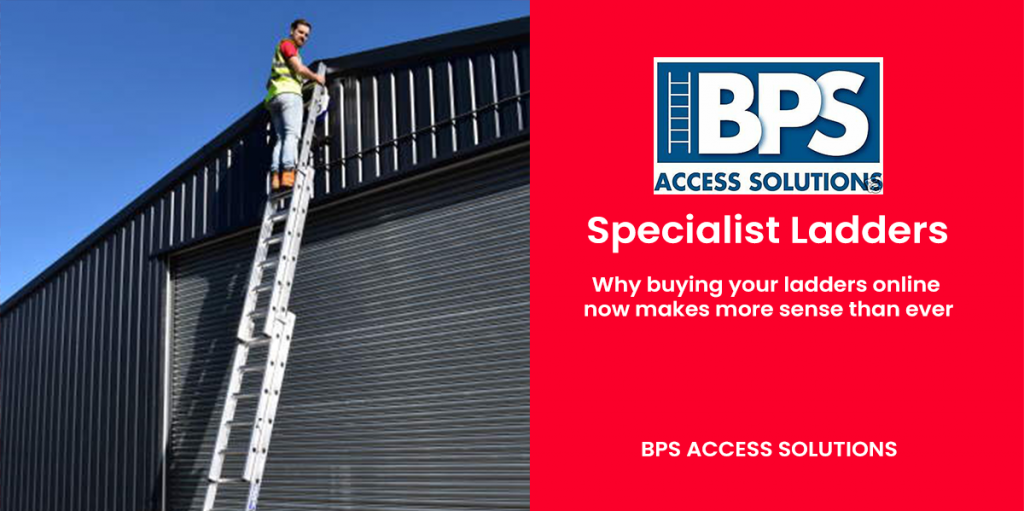Specialist ladders and what they’re used for
Ladders are a diverse group of equipment. There are many different types, each with their own uses and individual features. The ladders most normal, non-professional users have used themselves are the standard two-legged ladder and the step ladder. These are the most common types of ladder, and they are what practically all other types of ladder are based upon.
But there are many other ladders which are specifically designed for certain tasks or conditions. These ladders are generally less common and may look strange if you have no idea what they’re actually used for. If that’s you, we’ll run through a few specialist ladders and explain a bit more about them below.
Standard ladders
Before discussing some specialist ladders, we’ll quickly run through the two most common types of ladder – two-legged ladders and step ladders. These two types of ladder are so popular because of their simple, effective design. They do what they do very well, so most of the time non-professional users will be fine using these types with just a few small variations. Common variations on basic two-legged ladders and step ladders are extendable sections which add a bit of extra height. Generally, the further away the design strays from these two common types, the more specialised a ladder is for a particular role.
Fibreglass ladders
Fibreglass ladders aren’t necessarily specialised in terms of their features. Instead, their specialisation is simply that they are made of fibreglass and they most commonly come as stepladders. Unlike metal, which is what most modern ladders are made of, fibreglass does not conduct electricity. This makes fibreglass ladders perfect for use in situations where work is being carried out near electricity and there is a high risk of electrocution. Because fibreglass ladders can’t conduct electricity, workers are at significantly lower risk of electrocution when using them. Additionally, fibreglass is reasonably lightweight, meaning these ladders are easy to transport.
Telescopic ladders
Telescopic ladders aren’t designed specifically for use in any particular trade or professional setting, but their form factor makes them a very popular choice in situations where frequent transportation is likely. Unlike your typical extension ladder which has two or more large sections which slide past each other to provide additional length, telescopic ladders have many extendable sections. In fact, they feature extendable sections in between every rung, meaning that they are very small when fully folded away. This tiny form factor means they can easily fit inside a small car boot, ready for use if needed. Again, telescopic ladders aren’t specialised for any situation in particular, they’re just great in terms of transportability.
Window cleaning ladders
Window cleaning ladders are, of course, specially adapted for cleaning windows. While homeowners may decide to buy a window cleaning ladder to use when they clean their own windows, the majority of users are professionals. Window cleaning ladders are unusual in their design as they have an a-shaped frame. The two legs at the bottom are generally a little wider apart than a standard ladder and they come together in a point at the top which usually has some form of grip to rest against the wall. The reason for this unusual design is stability, as the A-shape shifts the centre of gravity towards the middle, allowing users to reach further without losing balance.
Tripod ladders
Tripod ladders are similar to window cleaning ladders in the sense that they also have an a-shaped frame. However, unlike window cleaning ladders, tripod ladders are able to stand on their own thanks to a third leg. Tripod ladders are specialist ladders which are primarily used in outdoor applications, such as orchard work or gardening. The third leg allows them to be used on soft or uneven ground and causes minimal disturbance to flower beds or other surfaces on the ground. Tripod ladders shouldn’t be used in place of normal step ladders, meaning they are one of the most specialised and least used of all ladder types.
Roof ladders
Like window cleaning ladders, roof ladders do exactly what they say on the tin. Roof ladders are effectively an extension ladder with two large hooks on the top which fit over the ridge of the roof to keep the ladder in place. On the opposite side of the ladder to the hooks are two wheels which allow the ladder to slide up the roof. Many roof ladders also feature spacers of some kind which protect the roof surface from damage or scratching when in use. Most home users won’t have any need for their own roof ladder, but they are obviously very popular with professionals such as roofers and cleaners.
While most people will never have any need to buy or use any of these ladders, they serve an important purpose for professional users in many different manual industries. At BPS Access Solutions we stock all of the ladder types discussed in this article plus many more.
If you would like to know more about any of these ladders, or would like guidance from one of our experts, please get in touch today.
No related posts.



